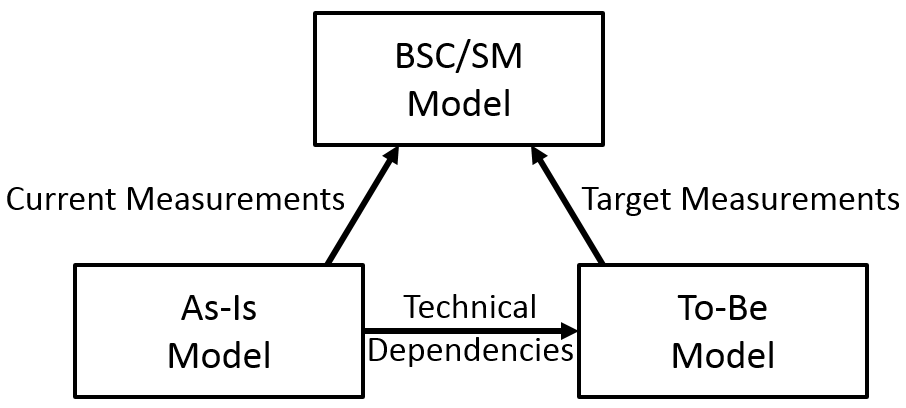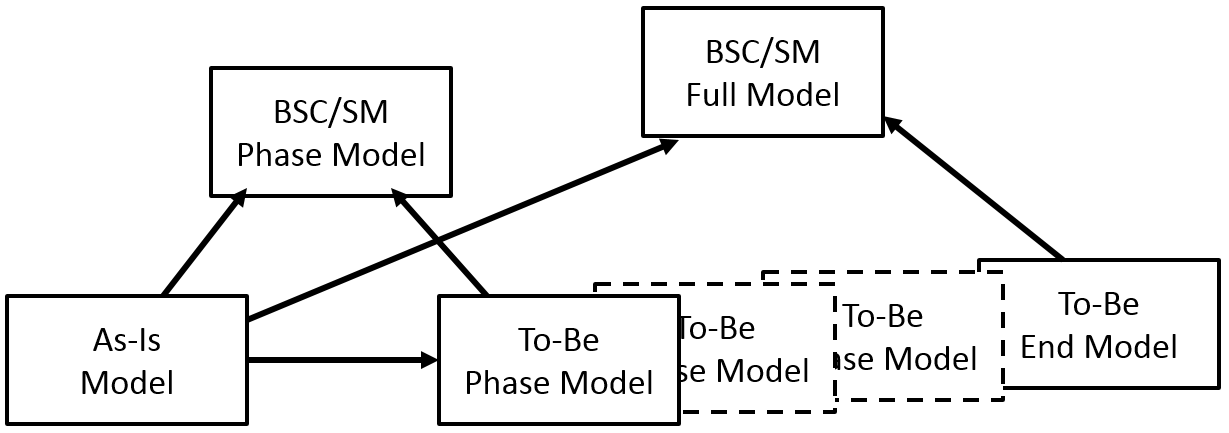VDML Support for Balanced Scorecard and Strategy Map
The Balanced Scorecard (BSC) and Strategy Map (SM) are well-known, abstract models for structuring business transformation objectives. The analysis of objectives helps refine a strategic plan, and the resulting objectives provide a basis for continuing assessment of progress.
BSC/SM objectives represent desired changes to the state of the business—how changes to the design/operation of the business will achieve improvements. Thus the changes represented by BSC/SM objectives represent the difference between VDML As-Is and To-Be models.
The BSC defines four perspectives that classify objectives: (1) Learning and Growth, (2) Internal, (3) Customer, and (4) Financial. This classification drives a broader analysis starting with the development of capabilities (Learning and Growth), through development of internal methods and processes (Internal), to delivery of customer value (Customer), and finally to enterprise success and sustainability (Financial).
The Strategy Map introduces causal relationships—some objectives depend on achievement of other objectives. An internal process will not be successful without the capabilities that support it (e.g., people, machines, know-how).
A VDML model represents the current or future state (sometimes the past) of the business and associated operating measurements. A model could involve multiple lines of business and multiple value streams.
VDML models can extend the BSC/SM analysis and support more robust transformation planning and assessment. The diagram, below, depicts this.

VDML models for BSC SM
So a VDML To-Be model can represent the improvements in performance and value creation if the strategy is successful. As the basis for objectives, these To-Be measurements must be compared to corresponding measurements in an As-Is (current state) model. The As-Is model will change as the transformation progresses. If the transformation goes as planned, the As-Is model will become the same as the To-Be model (transformation complete).
VDML can represent many of the measurements of interest for the BSC/SM objectives, so a BSC/SM objective may obtain its target measurement from the To-Be model and its current measurement from the As-Is model.
VDML can represent objectives of the BSC Financial Perspective as As-Is and To-Be value proposition measurements and market segment forecasts. However, VDML does not provide support for the development of these market forecasts. For example, profit is essentially price minus cost. VDML
supports cost detail, but price is a management decision based on market analysis. Market share is a forecast based on price and other factors including future competition. VDML can capture those measurements, but does not provide support for market analysis.
From a VDML perspective, the causal relationships of Strategy Maps (i.e., dependencies between objectives) are of six different types: (1) changes to enterprise capabilities (i.e., “capital” in Learning and Growth) that are necessary for implementation of Internal Perspective value stream changes, (2) changes to capabilities that increase customer value (Customer Perspective) such as adoption of an advanced technology, (3) changes to capabilities that improve investor value (Financial Perspective) such as development of intellectual property, (4) changes to a value stream (potentially involving multiple activity changes) that affect activity contributions to customer value (Customer Perspective), (5) changes to the value stream that improve investor value (Financial Perspective) such as cost reductions, and (6) changes in customer satisfaction levels that drive market changes reflected in investor value (Financial Perspective).
While these are all supported by VDML, they require two VDML models—an As-Is model and a To-Be model. Type (1) can be observed by a change in capabilities (new or modified) between the As-Is and To-Be models. Type (2) can be observed as value stream changes that improve desired customer value proposition measurements. Type (3) requires human recognition of the value investors will place on improved enterprise capabilities. Type (4) can be observed by tracing the sources of changes to the customer values in the To-Be model to the relevant customer value contributions that are improved from the As-Is model. Type 5 can be observed from changes in value contributions (such as cost reductions) that have a direct impact on investor value. Type 6 is based on changes in customer value propositions but it requires market insight and feedback regarding trends and competition to determine the impact on investor value.
In a substantial transformation, there must be phases of implementation. Without objectives (or intermediate target objectives) for phases, management would have difficulty assessing progress on a long-duration project with multiple components. Each phase should be represented by a VDML model for the expected state of the business at the end of the phase. As the transformation progresses, a series of As-Is models would be created to represent the new, current state of the business. The As-Is model evolves toward the To-Be model so that measurements in the current state depict progress toward To-Be targets as depicted in the diagram, below.
The BSC/SM model then becomes a series of phase models with As-Is and To-Be supporting models to define intermediate targets—see the diagram, below. The To-Be VDML model of a phase becomes the expected As-Is model of the next phase, and the BSC/SM short-term, phase model represents the objectives of the current phase. The overall BSC/SM model can be derived from the initial As-Is model and the final To-Be model.

Modeling transformation phases
While the full BSC/SM model can be stable (unless the end state of the business evolves), the current phase BSC/SM model will be incrementally based on new versions of the As-Is model as the transformation progresses, and it will be based on new To-Be models as new phases are started.
In summary, VDML can provide significant value in validating the strategy, setting and evaluating objectives that identify causal relationships and developing the transformation plan. However, the relationships between the BSC/SM objectives and the VDML models are diverse and require incremental alignment with new versions of VDML models. Development of needed modeling techniques is left for VDML implementers to explore.

